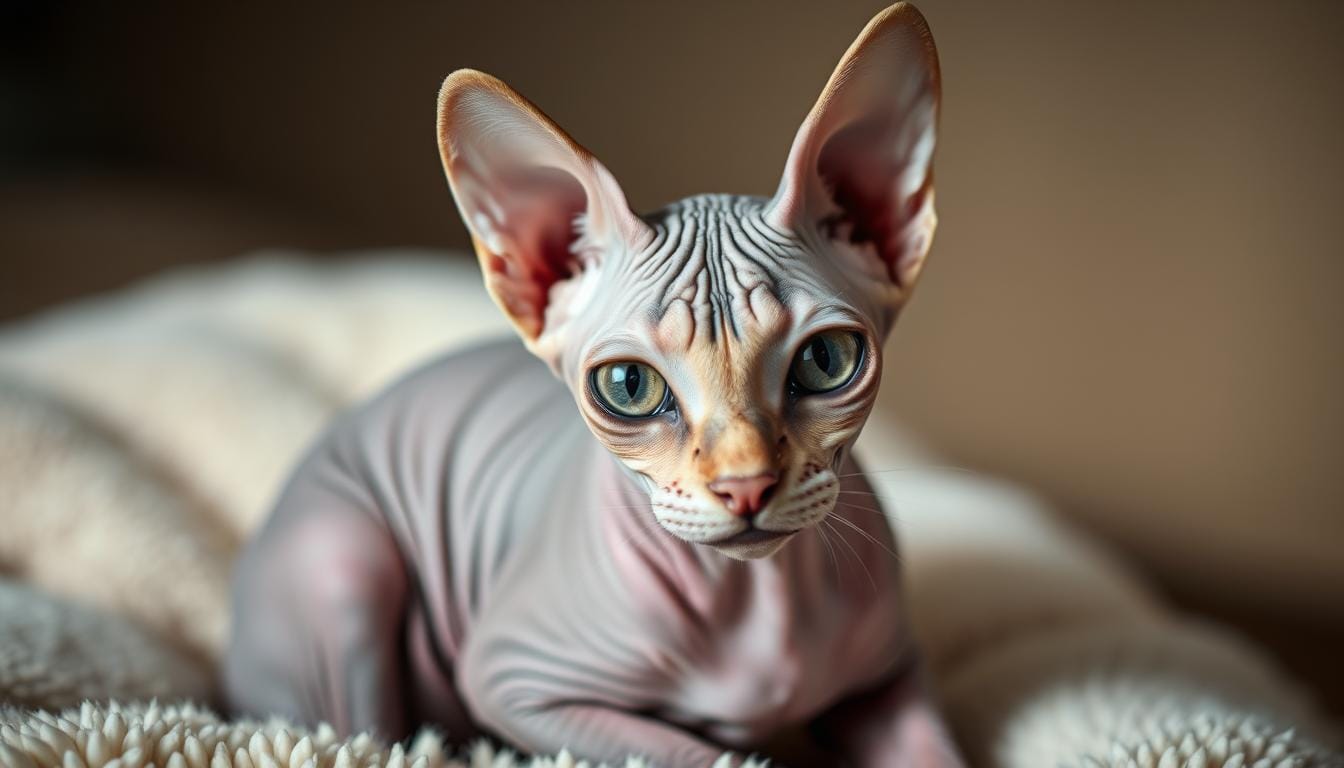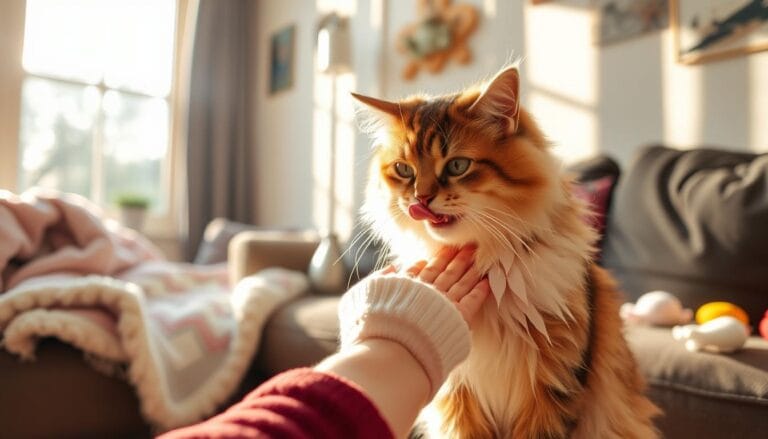Why a Hairless Cat Might Be Your Perfect Pet
Hairless cats are smart and can learn commands. They make great pets for many families. We’re thinking of getting one for our home.
These cats, also called “cat with no fur,” are very loyal. They love their owners a lot. This makes them perfect for those who want a pet that’s easy to care for.
Table of Contents
We’re excited to learn more about hairless cats. They’re great for people with allergies because they don’t shed. They’re also easy to clean up after.
Introduction to Hairless Cats
Hairless cats, like the Sphynx, are very loving and social. They’re perfect for many families. We’ll talk about why they’re good pets, like how easy they are to groom and how well they do indoors.
Key Takeaways
- Hairless cats are known for their intelligence and ability to understand commands.
- They are a great option for people who suffer from allergies due to their hairless nature.
- Hairless cats are low-maintenance pets that require less grooming than furry breeds.
- They are prone to sunburn and require precautions like limiting sun exposure and using cat-approved sunscreen.
- Hairless cats produce more oil on their skin than furry cats, making them prone to acne and requiring weekly baths with cat-safe shampoo.
- Regular ear cleaning is essential for hairless cats due to their large ears, which can accumulate dirt and earwax.
Understanding the Unique World of Hairless Cats
Hairless cat breeds have become popular for their unique looks and loving nature. They are not completely hypoallergenic, as many think. They produce fewer allergens than furry cats but can cause allergic reactions in some.
The history of hairless cats goes back to the Aztecs. Their popularity grew in the early 2000s because of their looks and friendly nature. Now, breeds like the Sphynx, Peterbald, Donskoy, and Bambino are known for their special traits.
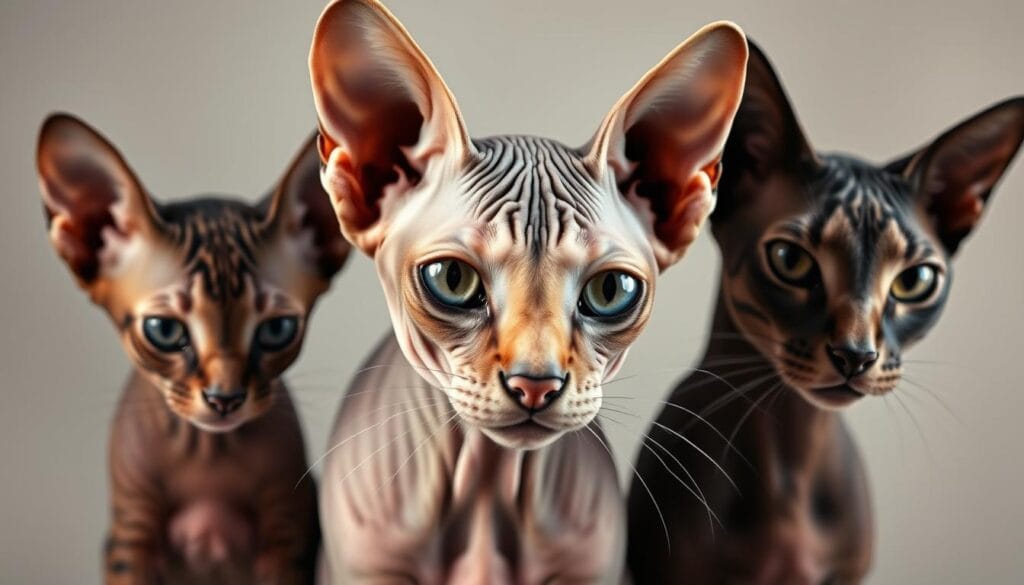
- They need special care, like regular baths and sun protection, because they don’t have fur.
- They can get sunburn and skin infections, so they need to be watched when outside.
- They have a fast metabolism, which means they eat a lot and have lots of energy.
Exploring hairless cats means understanding their needs and traits. This way, we can give them the best care. We can also enjoy their beauty and the joy they bring as pets.
The Truth About Living with a Hairless Cat
Living with a black hairless cat is special and rewarding. These cats love people and enjoy being around them. They are often admired for their sleek, wrinkled skin in pictures.
One key thing about hairless cats is they need to be bathed often. Unlike furry cats, they must be bathed every 2-4 weeks. This helps keep their skin clean and is a great way to bond with them.
It’s important to think about their health too. Hairless cats can get sunburned and frostbitten because they don’t have fur. They need protection in extreme weather. Also, regular vet visits are key to keep them healthy.
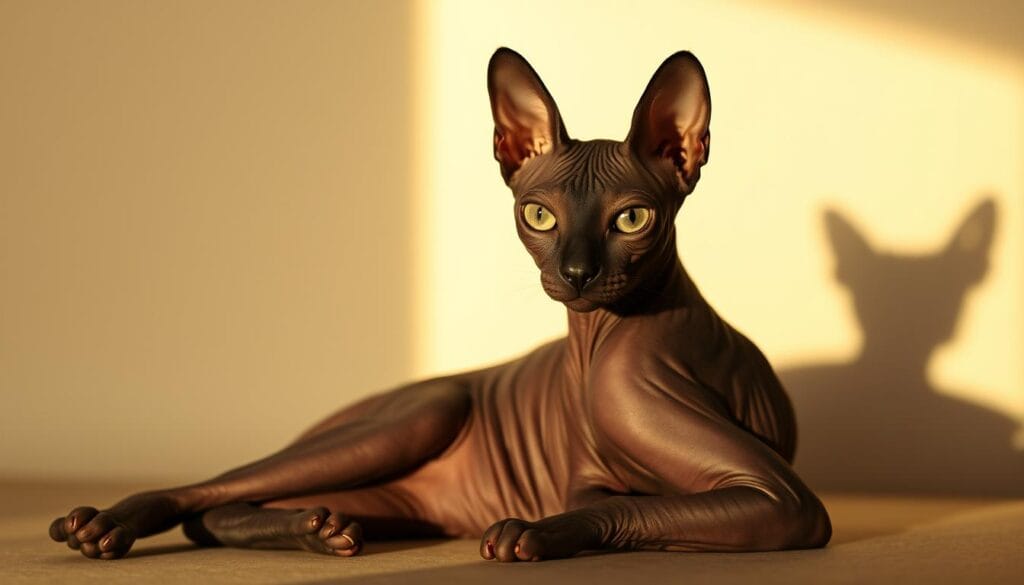
Hairless-cats are very loyal and loving, like dogs. They are perfect for those who want a pet that’s easy to care for but gives lots of love. Whether you’re looking at pictures or thinking of getting one, these cats can add joy and companionship to your life.
Popular Hairless Cat Breeds to Consider
There are many hairless cat breeds to choose from. These cats are loved for their unique looks and loving nature. The Sphynx, from Canada in the 1960s, is one of the most famous.
The Sphynx is known for its sleek, muscular body. It’s a favorite among hairless cat fans. Other breeds like the Peterbald, Donskoy, and Bambino also stand out. Each has its own special traits.
Some key features of these breeds include:
- The Sphynx: known for its sleek and muscular body
- The Peterbald: recognized for its slender and athletic build
- The Donskoy: notable for its unique appearance and affectionate nature
- The Bambino: a cross between a Sphynx and a Munchkin, known for its small size and playful personality
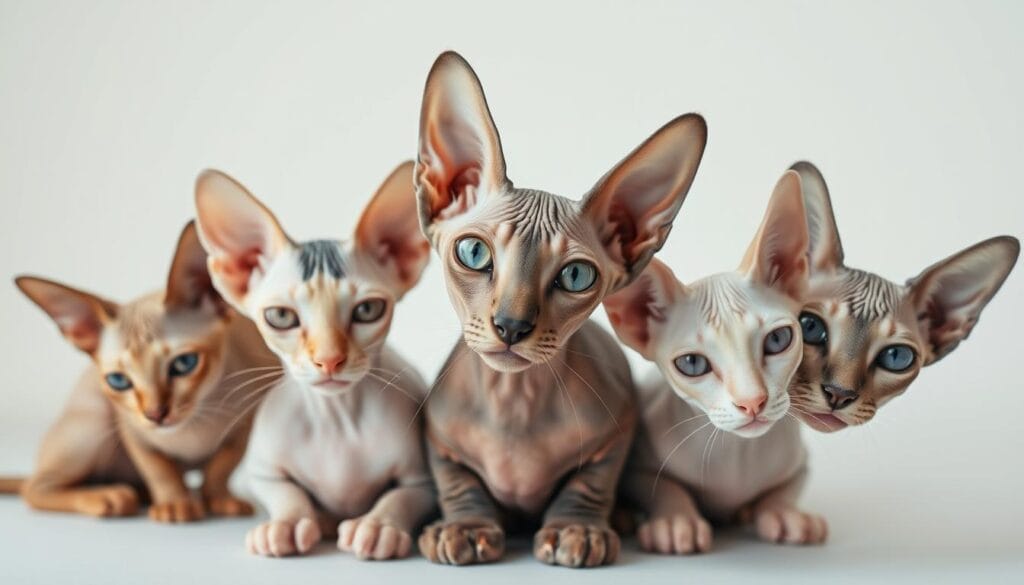
These hairless cat breeds are not just unique-looking. They also need special care. They need regular baths to keep their skin healthy. With proper care, a hairless cat can be a loving and wonderful pet.
Temperature Regulation and Care Requirements
Thinking about getting a hairless-cat? It’s key to know their special care needs. Hairless-cats, like the sphynx sphynx, need a warm spot to feel comfy.
So, are hairless cats hypoallergenic? They might be better for those with allergies, but they’re not completely safe. They need regular grooming to stay healthy and avoid allergies. Here’s what you need to do:
- Keep their home warm, between 68-72°F (20-22°C)
- Bathe them every two weeks to keep their skin clean
- Keep them out of direct sunlight and use sunscreen
- Take them to the vet often to check their health
By following these steps, you can make sure your hairless cat is happy and healthy. Their playful and loving nature makes them a favorite among many.
Grooming and Maintenance of Your Hairless Cat
As owners of a hairless-cat, we know how vital grooming and maintenance are. Cats like the Sphynx need special care because of their skin and lack of fur. We must focus on their skin care, bathing, and sun protection to avoid health problems.
A hairless cat needs regular baths to avoid oil buildup on their skin. Bathing them once a week with a gentle shampoo made for hairless-cats is best. It’s also key to clean their ears and nails often to prevent infections and keep them clean. For example, the Earthbath Hypo-Allergenic Cat Shampoo is a good choice for bathing, and the Earthbath Hypo-Allergenic Grooming Wipes are great for quick cleanups.
Protecting hairless-cats from the sun is also important. We can give them a sunny spot or take them for walks on sunny days. But, we must apply sunscreen made for cats to prevent sunburn. By following these grooming and maintenance tips, we can ensure our hairless-cats live a happy and healthy life.
Skin Care Routine
- Regular bathing with a gentle shampoo
- Cleaning ears and nails to prevent infections
- Applying sunscreen to prevent sunburn
Bathing Schedule
Bathing your hairless cat once a week is usually recommended. But, this can change based on their needs and lifestyle. It’s important to talk to a vet to find the best bathing schedule for your pet.
Health Considerations and Veterinary Care
Exploring hairless cat breeds reveals unique health challenges. Cats like the Sphynx face skin problems and heart issues. Regular vet visits are key to prevent and treat these problems.
Health issues for hairless-cats include skin problems and heart conditions. Regular check-ups help catch problems early. Vaccinations and parasite control also keep them healthy.
Some specific health concerns for hairless-cats are:
- Sphynx cats often have hypertrophic cardiomyopathy, a heart issue needing regular checks.
- Without fur, hairless-cats are at risk for sunburn and temperature problems.
- They also need regular dental cleanings because of common dental issues.
Knowing the health needs of hairless-cats helps us care for them better. Whether it’s a Sphynx, Donskoy, or another breed, a skilled vet is essential. They ensure your cat stays healthy and happy.
Cost of Owning a Hairless Cat
Owning a hairless cat is a big deal, both in time and money. Before we bring one home, we must know the costs. The first cost is buying the cat, which can be $1,500 to $6,000. We also need to think about the cost of food, litter, and vet bills.
Many ask, are hairless-cats good for people with allergies? They might be, but it depends on the person. The cost of a hairless cat isn’t just the initial price. There are ongoing costs like food, litter, and vet care, which can be $2,000 a year. Here are some estimated costs to consider:
- Monthly diet costs: $20 to $60
- Professional grooming costs: $30 to $70 per session
- Annual miscellaneous expenses: $100 to $300
When thinking about owning a hairless cat, insurance is key. It helps with vet bills that come out of nowhere. With the right care, hairless-cats can be amazing pets. Their looks can bring a lot of joy.
Are Hairless-Cats Right for Your Family?
Thinking about getting a hairless cat? It’s key to consider your home, time, and family life. Hairless-cats, like the Sphynx, love people and need lots of attention. They’re perfect for many families but not all.
These cats need lots of time and a cozy spot. They’re not for busy homes or cold places.
Living Arrangements
Before getting a hairless cat, check your home. Is it big enough for them to play? Can you keep it warm and comfy? These are important questions.
Time Commitment
Hairless-cats need lots of care. They need regular grooming and lots of attention. If you’re always busy, they might not be the best fit.
Family Dynamics
Hairless-cats are great with kids. They’re gentle and patient. But, teach kids how to handle them softly. With the right care, they’ll be a loving family member.
- Supervising interactions between children and cats to ensure safety
- Teaching children how to handle cats gently and with care
- Providing a stable and comfortable environment for your cat
Think about these points to see if a hairless cat fits your family. With the right care, they’ll be a loyal friend.
Conclusion: Embracing the Beauty of Hairless Companions
As we wrap up our look at hairless cats, we’re filled with wonder at their beauty and the happiness they bring. From the famous Sphynx to the playful Bambino, these cats have won over many hearts. Their special looks and loving nature make them unique friends.
Hairless cats need special care, but the joy they bring is worth it. With the right grooming, warmth, and food, they can be happy and healthy family members. They’re also great for those with allergies, as they don’t shed.
If you’re thinking about getting a hairless cat, know each one is different. Learn about their personalities and needs. With the right care, these amazing cats can fill your home with love and laughter.
FAQ
Are hairless-cats hypoallergenic?
Hairless-cats make fewer allergens than furry ones. But, they’re not totally hypoallergenic. Some people might react to them.
How do hairless-cats regulate their body temperature?
Hairless-cats can’t handle extreme temperatures well. They need a warm place to live. A heated bed or a cozy blanket helps them stay warm.
They should avoid drafts and cold spots.
What are the grooming requirements for a hairless cat?
Hairless-cats need regular skin care to stay healthy. They must be bathed often to avoid oil buildup. They also need sun protection.
What health issues are common in hairless-cats?
Hairless-cats face health problems like skin issues and heart conditions. Regular vet visits are key to prevent and treat these.
How much does it cost to own a hairless cat?
Owning a hairless cat is a big deal, time-wise and money-wise. The initial cost includes buying the cat and getting the right gear. Then, there’s the ongoing cost of food, litter, and vet bills.
Are hairless-cats suitable for all families?
Hairless-cats need lots of attention and interaction. They’re not for families who are always busy. They also prefer warmer places, not cold ones.
There are no reviews yet. Be the first one to write one.

